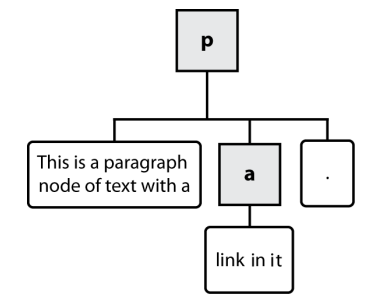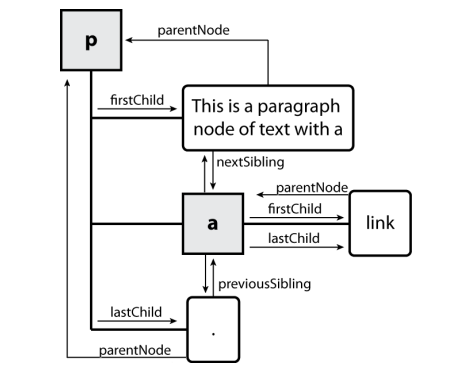CSE 154
Lecture 9: The DOM Tree
The Keyword this
this.fieldName // access field
this.fieldName = value; // modify field
this.functionName(parameters); // call method
JS
All JavaScript code actually runs inside of an object
By default, code runs in the global window object (so this === window)
- All global variables and functions you declare become part of
window
The this keyword refers to the current object
Event Handler Binding
window.onload = function() {
document.getElementById("textbox").onmouseout = booyah;
};
function booyah() { // booyah knows what object it was called on
this.value = "booyah";
}
JS
output
Event handlers attached unobtrusively are bound to the element
Inside the handler, that element becomes this
The DOM Tree

The elements of a page are nested into a tree-like structure of objects
The DOM has properties and methods for traversing this tree
DOM Versus innerHTML Hacking
Why not just code this way?
function slideClick() {
document.getElementById("main").innerHTML += "<p>A paragraph!</p>";
}
JS
Imagine that the new node is more complex:
- Ugly: bad style on many levels (e.g., JS code embedded within HTML)
- Error-prone: must carefully distinguish " and '
- Can only add at beginning or end, not in middle of child list
function slideClick() {
document.getElementById("main").innerHTML += <p style='color: red; " +
"margin-left: 50px;' " + "onclick='myOnClick();'>" +
"A paragraph!</p>";
}
JS
Creating New Nodes
// create a new <h2> node
let newHeading = document.createElement("h2");
newHeading.innerHTML = "This is a heading";
newHeading.style.color = "green";
JS
| Name | Description |
|---|---|
| document.createElement("tag") | creates and returns a new empty DOM node representing an element of that type |
| document.createTextNode("text") | creates and returns a text node containing given text |
Merely creating an element does not add it to the page
You must add the new element as a child of an existing element on the page...
Modifying the DOM Tree
let p = document.createElement("p");
p.innerHTML = "A paragraph!";
document.getElementById("main").appendChild(p);
JS
Every DOM element object has these methods:
| Name | Description |
|---|---|
| appendChild(node) | places the given node at end of this node's child list |
| insertBefore(new, old) | places the given node in this node's child list just before old child |
| removeChild(node) | removes the given node from this node's child list |
| replaceChild(new, old) | replaces given child with new nodes |
Complex DOM Manipulation Problems
How would we do each of the following in JavaScript code? Each involves modifying each one of a group of elements...
- When the Go button is clicked, reposition all the divs of class 'puzzle' to random x/y locations
- When the user hovers over the maze boundary, turn all maze walls red
-
Change every other item in the
ullist with id of 'tas' to have a gray background
Selecting Groups of DOM Objects
Methods in document and other DOM objects:
| Name | Description |
|---|---|
| getElementsByTagName(tag) | returns array of descendents with the given tag, such as "div" |
| getElementsByName(name) | returns array of descendents with the specified name (mostly useful for accessing form controls) |
| querySelector(selector) | returns the first element that would be matched by the given CSS selector string |
| querySelectorAll(selector) | returns an array of all elements that would be matched by the given CSS selector string |
Getting All Elements of a Certain Type
Highlights all paragraphs in the document:
let allParas = document.querySelectorAll("p");
for (let i = 0; i < allParas.length; i++) {
allParas[i].style.backgroundColor = "yellow";
}
JS
<body>
<p>This is the first paragraph</p>
<p>This is the second paragraph</p>
<p>You get the idea...</p>
</body>
HTML
This is the first paragraph
This is the second paragraph
You get the idea...
output
Complex Selectors
Highlight all paragraphs inside of the section with ID 'address':
let addrParas = document.querySelectorAll("#address p");
for (let i = 0; i < addrParas.length; i++) {
addrParas[i].style.backgroundColor = "yellow";
}
JS
<p>This won't be highlighted!</p>
<div id="address>
<p>1234 Street</p>
<p>Seattle, WA</p>
</div>
HTML
This won't be highlighted!
1234 Street
Seattle, WA
output
Common querySelectorAll Issues
Many students forget to write . or # in front of a class or
id
// get all buttons with a class of "control"
let gameButtons = document.querySelectorAll("control");
let gameButtons = document.querySelectorAll(".control");
JS
querySelectorAll returns an array, not just a single element; must loop
over the results
-
document.querySelectorreturns just the first element that matches, if that's what you want
// set all buttons with a class of "control" to have red text
document.querySelectorAll(".gamebutton").style.color = "red";
let gameButtons = document.querySelectorAll(".gamebutton");
for (let i = 0; i < gameButtons.length; i++) {
gameButtons[i].style.color = "red";
}
JS
Q: Can I still select a group of elements using querySelectorAll even if
my CSS file doesn't have any style rule for that same group? (A: Yes!)
Problems with Reading/Changing Styles
HTML
window.onload = function() {
document.getElementById("clickme").onclick = biggerFont;
};
function biggerFont() {
let button = document.getElementById("clickme");
let size = parseInt(button.style.fontSize);
button.style.fontSize = (size + 4) + "pt";
}
JS
output
The style property lets you set any CSS style for an element
A catch: you can only use this to read styles set in the html
or with the DOM .style. You cannot read css properties from this.
Accessing Elements' Existing Styles
window.getComputedStyle(element).propertyName;
JS (template)
function biggerFont2() {
let button = document.getElementById("clickme2");
let size = parseInt(window.getComputedStyle(button).fontSize);
button.style.fontSize = (size + 4) + "pt";
}
JS (example)
output
getComputedStyle method of global window object accesses existing styles
Common Bug: Incorrect Usage of Existing Styles
The following example attempts to add 100px to the top of main, but fails.
Consider the case when main has top set to "200px". Then
this code would update style.top to be the invalid value of "200px100px"
let main = document.getElementById("main");
main.style.top = window.getComputedStyle(main).top + 100 + "px";
JS
A corrected version:
main.style.top = parseInt(window.getComputedStyle(main).top) + 100 + "px";
JS
Getting/Setting CSS Classes
function highlightField() {
// turn text yellow
let text = document.getElementById("text");
if (!text.className) {
text.className = "highlight";
} else if (text.className.indexOf("invalid") < 0) {
text.className += "highlight"; // awkward
}
}
JS
JS DOM's className property corresponds to HTML class
attribute
Somewhat clunky when dealing with multiple space-separated classes as one big string
Getting/Setting CSS Classes with classList
function highlightField() {
// turn text yellow
let text = document.getElementById("text");
if (!text.classList.contains("invalid")) {
text.classList.add("highlight");
}
}
JS
classList collection has methods add, remove,
contains, and toggle to manipulate CSS classes
Similar to existing className DOM property, but don't have to manually
split by spaces
Removing a Node From the Page
function slideClick() {
let bullet = document.getElementById("removeme");
bullet.parentNode.removeChild(bullet);
}
JS
An odd idiom: obj.parentNode.remove(obj)
Types of DOM Nodes
This is a paragraph of text with a link in it.
HTML

Element Nodes (HTML tag)
- Can have children and/or attributes
Text Nodes (text in a block element)
Attribute Nodes (attribute/value pair)
- text/attributes are children in an element node
- Cannot have children and/or attributes
- Not usually shown when drawing the DOM tree
Traversing the DOM Tree Manually
Every node's DOM object has the following properties:
| Name(s) | Description |
|---|---|
| firstChild, lastChild | start/end of this node's list of children |
| childNodes | array of all of this node's children |
| nextSibling, previousSibling | neighboring nodes with the same parent |
| parentNode | the element that contains this node |
Complete list of DOM node properties
Browser incompatibility information (IE6 sucks)
DOM Tree Traversal Example
This is a paragraph of text with a
link.
HTML

Element vs. Text Nodes
This is a paragraph of text with a
link.
HTML
Q: How many children does the div have?
A: 3
- an element node representing the
<p> - two text nodes representing "\n\t" (before/after the paragraph)
Q: How many children does the paragraph have? The a tag?
